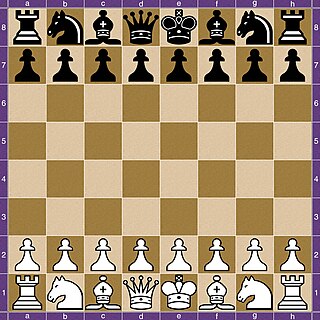In chess, a fork is a tactic in which a piece attacks multiple enemy pieces simultaneously. The attacker usually aims to capture one of the forked pieces. The defender often cannot counter every threat. A fork is most effective when it is forcing, such as when the king is put in check. A fork is a type of double attack.
Zugzwang is a situation found in chess and other turn-based games wherein one player is put at a disadvantage because of their obligation to make a move; a player is said to be "in zugzwang" when any legal move will worsen their position.
The fifty-move rule in chess states that a player can claim a draw if no capture has been made and no pawn has been moved in the last fifty moves. The purpose of this rule is to prevent a player with no chance of winning from obstinately continuing to play indefinitely or seeking to win by tiring the opponent.
Stalemate is a situation in chess where the player whose turn it is to move is not in check and has no legal move. Stalemate results in a draw. During the endgame, stalemate is a resource that can enable the player with the inferior position to draw the game rather than lose. In more complex positions, stalemate is much rarer, usually taking the form of a swindle that succeeds only if the superior side is inattentive. Stalemate is also a common theme in endgame studies and other chess problems.
The Lucena position is one of the most famous and important positions in chess endgame theory, where one side has a rook and a pawn and the defender has a rook. Karsten Müller said that it may be the most important position in endgame theory. It is fundamental in the rook and pawn versus rook endgame. If the side with the pawn can reach this type of position, they can forcibly win the game. Most rook and pawn versus rook endgames reach either the Lucena position or the Philidor position if played accurately. The side with the pawn will try to reach the Lucena position to win; the other side will try to reach the Philidor position to draw.

Checkmate is any game position in chess and other chess-like games in which a player's king is in check and there is no possible escape. Checkmating the opponent wins the game.
In chess, the fianchetto is a pattern of development wherein a bishop is developed to the second rank of the adjacent b- or g-file, the knight pawn having been moved one or two squares forward.
In chess, a cross-check is a tactic in which a check is played in response to a check, especially when the original check is blocked by a piece that itself either delivers check or reveals a discovered check from another piece. Sometimes the term is extended to cover cases in which the king moves out of check and reveals a discovered check from another piece ; it does not generally apply to cases where the original checking piece is captured.
In chess, a passed pawn is a pawn with no opposing pawns to prevent it from advancing to the eighth rank; i.e. there are no opposing pawns in front of it on either the same file or adjacent files. A passed pawn is sometimes colloquially called a passer. Passed pawns are advantageous because only the opponent's pieces can stop them from promoting.
The Saavedra position is one of the best-known chess endgame studies. It is named after the Spanish priest Fernando Saavedra (1849–1922), who lived in Glasgow during the late 19th century. Though not a strong player, he spotted a win involving a dramatic underpromotion in a position previously thought to have been a draw.
The GBR code is a system of representing the position of chess pieces on a chessboard. Publications such as EG use it to classify endgame types and to index endgame studies.

EG is a magazine which publishes endgame studies and discusses various aspects of the endgame in chess. The letters "EG" signify "End Game" and also the Latin phrase exempli gratia. While many chess magazines include sections for endgame studies, EG is unique for its exclusive focus.
David Vincent Hooper, born in Reigate, was a British chess player and writer. As an amateur, he tied for fifth place in the 1949 British Championship at Felixstowe. He was the British correspondence chess champion in 1944 and the London Chess Champion in 1948. He played in the Chess Olympiad at Helsinki in 1952.
Much literature about chess endgames has been produced in the form of books and magazines. A bibliography of endgame books is below.

Ladislav Prokeš was a Czech chess master and one of the most prolific composers of endgame studies in chess. He was born and died in Prague.
Domenico Lorenzo Ponziani was an Italian law professor, priest, chess player, composer and theoretician. He is best known today for his chess writing.

The game of chess is commonly divided into three phases: the opening, middlegame, and endgame. There is a large body of theory regarding how the game should be played in each of these phases, especially the opening and endgame. Those who write about chess theory, who are often also eminent players, are referred to as "theorists" or "theoreticians".

André Chéron was a French chess player, endgame theorist, and a composer of endgame studies. He was named a FIDE International Master of Chess Composition in 1959, the first year the title was awarded.
Hugh Francis Blandford was a chess endgame composer born in Southampton, England.

Jean-Louis Preti was a musician and chess writer, specializing in the chess endgame.







